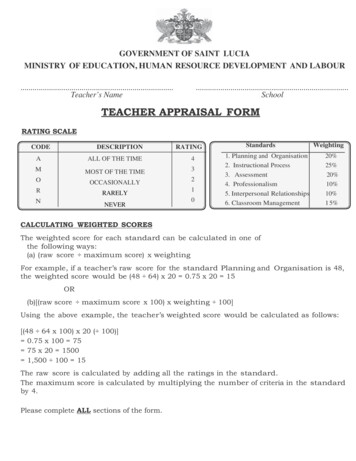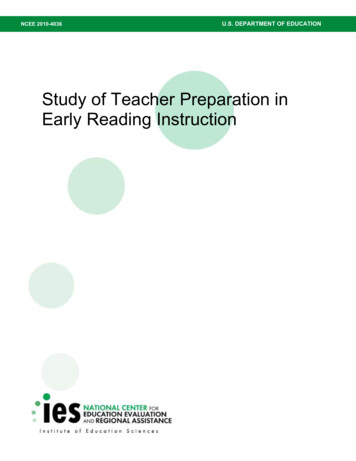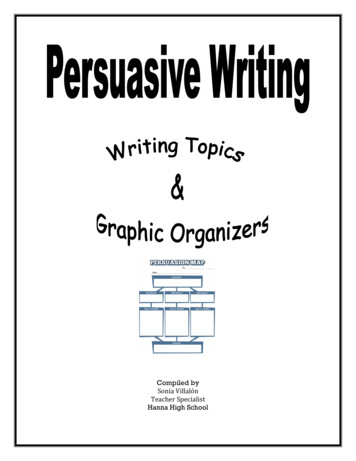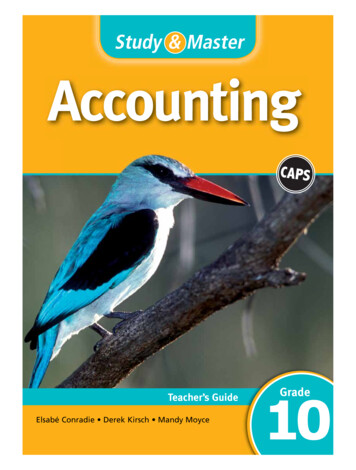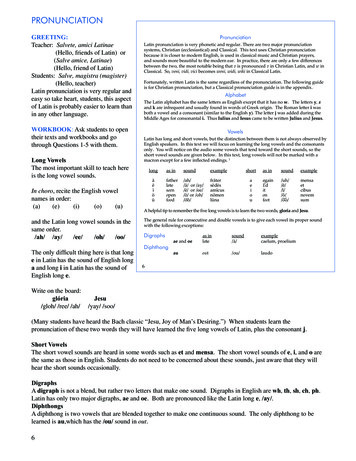
Transcription
PRONUNCIATIONGREETinG:Teacher: Salvete, amici Latinae(Hello, friends of Latin) or(Salve amice, Latinae)(Hello, friend of Latin)Students: Salve, magistra (magister)(Hello, teacher)Latin pronunciation is very regular andeasy so take heart, students, this aspectof Latin is probably easier to learn thanin any other language.WORKBOOK: Ask students to opentheir texts and workbooks and gothrough Questions 1-5 with them.Long VowelsThe most important skill to teach hereis the long vowel sounds.In choro, recite the English vowelnames in order:(a)(e)(i)(o)(u)and the Latin long vowel sounds in thesame order./ah/ /ay//ee//oh//oo/The only difficult thing here is that longe in Latin has the sound of English longa and long i in Latin has the sound ofEnglish long e.Write on the board:glória/gloh/ /ree/ /ah/PronunciationLatin pronunciation is very phonetic and regular. There are two major pronunciationsystems, Christian (ecclesiastical) and Classical. This text uses Christian pronunciationbecause it is closer to modern English, is used in classical music and Christian prayers,and sounds more beautiful to the modern ear. In practice, there are only a few differencesbetween the two, the most notable being that v is pronounced v in Christian Latin, and w inClassical. So, veni, vidi, vici becomes weni, widi, wiki in Classical Latin.Fortunately, written Latin is the same regardless of the pronunciation. The following guideis for Christian pronunciation, but a Classical pronunciation guide is in the appendix.AlphabetThe Latin alphabet has the same letters as English except that it has no w. The letters y, zand k are infrequent and usually found in words of Greek origin. The Roman letter i wasboth a vowel and a consonant (similar to the English y). The letter j was added during theMiddle Ages for consonantal i. Thus Iulius and Iesus came to be written Julius and Jesus.VowelsLatin has long and short vowels, but the distinction between them is not always observed byEnglish speakers. In this text we will focus on learning the long vowels and the consonantsonly. You will notice on the audio some vowels that tend toward the short sounds, so theshort vowel sounds are given below. In this text, long vowels will not be marked with amacron except for a few inflected endings. 1longas /ā/ or /ay//ē/ or /ee//ō/or /oh//oo/frātersēdēsamīcusnōmenlūnashortas /oo/mensaetcibusnovemsum A helpful tip to remember the five long vowels is to learn the two words, gloria and Jesu.The general rule for consecutive and double vowels is to give each vowel its proper soundwith the following exceptions:DigraphsDiphthongae and oeas inlatesound/ā/examplecaelum, proeliumauout/ou/laudo6Jesu/yay/ /soo/(Many students have heard the Bach classic “Jesu, Joy of Man’s Desiring.”) When students learn thepronunciation of these two words they will have learned the five long vowels of Latin, plus the consonant j.Short VowelsThe short vowel sounds are heard in some words such as et and mensa. The short vowel sounds of e, i, and o arethe same as those in English. Students do not need to be concerned about these sounds, just aware that they willhear the short sounds occasionally.DigraphsA digraph is not a blend, but rather two letters that make one sound. Digraphs in English are wh, th, sh, ch, ph.Latin has only two major digraphs, ae and oe. Both are pronounced like the Latin long e, /ay/.DiphthongsA diphthong is two vowels that are blended together to make one continuous sound. The only diphthong to belearned is au,which has the /ou/ sound in out.6
PRONUNCIATIONWORKBOOK:Complete Questions 6-8.ConsonantsThe Latin consonants have the same sounds as in English except as noted below. The rulesfor hard and soft c and g are usually true in English and always true in Latin. Note that softc and sc have different sounds in English and Latin.ConsonantsThe rules for soft and hard sounds of c,g, and sc are the same in English andLatin, the difference being that thereare no exceptions in Latin and there aremany in English.c, g, and sc are hard before a, o, u, and consonantshard c as in cat/k/culpa, clamohard g as in go/g/fuga, gloriahard sc as in scout/sk/scutumc, g, and sc are soft before e, i, ae, oesoft c as in charity/ch/soft g as in gem/j/soft sc as in shout/sh/caelumreginasciogn as in canyonch is hard as in chemistryj as in yes/ny//k//y/pugnochoroJesuss as in sing,never as in nose /z//s/mensat when followed by iand another vowel/tsee/gratiaSoft c and sc have the sound /s/ inEnglish. (ceiling, scene) In Latin soft cis /ch/ and soft sc is /sh/ which are notsounds they have in English.(In classical Latin c, g, and sc arealways hard, never soft.)The sound of gn is /ny/. Examples areonion, poignant, canyon, lasagnaAccentsFor the beginning Latin student, the most helpful information is not long and short vowels,but rather knowing what syllable to accent. In this text you will always know the accentedsyllable by following these easy rules. The last three syllables in a Latin word have names.a mi cusantepenult(2nd last)penult(next last)ultima(last)WORKBOOK:Complete Questions 9-16.Ultima comes from ultimus, meaning thelast, or ultimate. Penult comes from penultima,meaning next to last. Antepenult comes fromantepenultima, meaning before the penult.Latin words are always accented on either the penult or the antepenult, never onthe last syllable. In this text, if the accent is on the penult it will not have an accentmark, but if the accent is on the antepenult it will have an accent mark.amicusbutámbuloaccent on the penult - no markaccent on the antepenult - accent mark7Accents (Students do not need to reproduce the accent marks in their written work.)Knowing what syllable to accent is one of the most important helps to promote confident pronunciation. Vowelscan range from long to short and no one will notice much but an accent on the wrong syllable is noticeable.Write a mi cus on the board as it is above with the syllable names, and have students pronounce them with you.Recite them in the order antepenult, penult, and ultima. Think and say APU to help students remember thenames of the syllables in order from left to right. (If you have trouble with these words you can use last, nextlast and second last instead, although these terms can be confusing.)Latin words are accented on either the antepenult or the penult, never on the ultima.In this text always accent a word on the penult, unless there is an accent mark on the antepenult.WORKBOOK: Complete Questions 17-24 with your students.nOTE: Although Latin words are never accented on the last syllable, it is perfectly acceptable to stress thelast syllable while learning and reciting conjugations and declensions. The goal of the beginner is to learn theinflected endings and how to spell them, so emphasizing and exaggerating those endings is natural and helpful.The correct accents marks are given throughout the text and you should observe them when teaching vocabularyand try to observe them in translation exercises.7
UNIT I INTRODUCTION1ORAL RECiTATiOn/REViEWTeacher: Salvete, amici Latinae(Hello, friends of Latin)Students: Salve, magistra (magister)(Hello, teacher)UNIT I INTRODUCTION In this unit you will learn The Present System of the 1st Conjugation and the irregular verbsum. Latin verbs fall naturally into four groups or families called conjugations.Grammar Questions: 1-9The Grammar Review Questions are atthe end of the workbook. Don’t skipthis part of the review.The Unit Introductions are designed togive you and your students an overviewof the content of the unit. If you arenew to Latin, you are not expected tounderstand the content of this pagecompletely.2GRAmmAR - ChALK TALKStudents should have a Latin notebookopen for all lessons in case you haveanything you want them to write (notes,practice exercises, etc.). Ask studentsto read over the Unit I Introductionsilently before you ask questions. Look at the conjugation of the present tense of the English verb love. Notice that theEnglish verb love changes in the 3rd person singular which requires the ending s.1st person (person speaking)2nd person (person spoken to)3rd person (person spoken about)SINGULARI loveyou lovehe, she, it lovesPLURALwe loveyou lovethey love To conjugate a Latin verb is to say or write its forms in an organized chart similar to theone above. The six attributes of a Latin verb are: conjugation, person, number, tense, voice, and mood.In Latin, there are:Four conjugations1st, 2nd, 3rd, 4thThree personsfirst, second, and third personsTwo numberssingular, pluralSix tensespresent, imperfect, future (Present System)perfect, pluperfect, future perfect (Perfect System)Two voicesactive and passiveThree moodsindicative, imperative, subjunctive In this unit you will learn about conjugation, person, number, and tense, but not voiceand mood. (All verbs in this text are in the same voice and mood, active indicative.) Latin is a language of stems and endings. The three tenses of the Present System areall built on the present stem. The stem is the part of the word that doesn’t change. Theendings change for person, number, tense, voice, and mood.note to TeacherPay attention to your students. ifyou ask them to write conjugation8in their notebooks two times, makesure that they do it and that theyspell conjugation correctly. many students are careless and sloppy and will misspell words even when theyare copying from the board. Training in careful and conscientious work is an important part of education.Students will raise their level of neatness and accuracy only to the level that you demand.Scripted LessonLook at Bullet 2: Verb families in Latin are called? (conjugations) Write conjugation on the board and go overspelling by breaking down into syllables (con ju ga tion). Ask students to write conjugation two times in theirnotebooks. Bullet 5: What are the six characteristics (attributes) of a Latin verb? (conjugation, person, number,tense, voice, and mood) How many conjugations are there? (four) Name them. (1st, 2nd, 3rd, 4th) How manypersons are there? (three) Name them. (1st, 2nd, 3rd) Bullet 3: Who is the 1st person? (person speaking) Who isthe 2nd person? (person spoken to) Who is the 3rd person? (person spoken about) Bullet 5: How many numbersare there in grammar? (two) Name them. (singular and plural) Ask students to write singular and plural intheir notebooks and spell correctly. What does tense refer to? (time) What are the three dimensions of time?(past, present, future) How many Latin tenses are there? (six) Name them. (present, imperfect, future, perfect,pluperfect, future perfect) Recite tenses in choro (aloud together as a class) twice. What two attributes of verbswill we not study this year? (voice and mood) What two words describing voice and mood will you see in yourbook this year? (indicative active) You don’t have to know what these words mean this year. You will learnabout voice and mood in Second Form.WORKBOOK: Lesson 1, Complete Questions 1-6.8
UNIT IUNIT IVerBs1st ConJugation and SuMPresent SYsteMRomulus, Remus, and the She-wolfCapitoline Museums, RomeThis iconic statue of the ancient city of Rome depicts the twin brothers, Romulus and Remus,suckled by a she-wolf. The myth that the Romans were descended from ancestors so fierceand courageous they were raised by a she-wolf fits the national character of Rome, a citychosen by destiny to conquer and rule the world. Romulus founded Rome and became herfirst king, giving Rome its name.9Because all verbs in First Form arein the active voice and the indicativemood, there will be no lessons on voiceand mood for students.Fyi (FOR yOuR inFORmATiOn)VOICE: There are two voices in English and Latin, active and passive.Active voice: John ate the cookies.Passive voice: The cookies were eaten yesterday.In the active voice the subject performs the action of the verb.In the passive voice, the subject receives the action of the verb.In the passive voice, the actual doer of the action of the verb may be expressed by a prepositional phrase.Ex: The cookies were eaten by John yesterday.MOOD:There are three moods in Latin. (Some grammars count the infinitive as a mood.)The indicative mood is used for statements and questions. Ex: I have Latin homework.The imperative mood is used for commands. Ex: Do your homework.The subjunctive mood is used for subordinate clauses, imaginary statements, exhortation, contrary to fact,purpose, etc. Ex: If I were you I would do my homework.Let us do our homework.May, might, would, should, and let are helping verbs that indicate the subjunctive in English.The subjunctive is used very little in English, but is very common in Latin.9
LESSON I1LESSON IORAL RECiTATiOn/REViEWTeacher: Salvete, amici Latinae(Hello, friends of Latin)Students: Salve, magistra (magister)(Hello, teacher)In choro recitemus.First Conjugation - Present Tensepresent stemPersonGrammar Questions: 1-16(at the end of the workbook)2LATin SAyinGama-SingularPlural1stam-oI loveama-muswe love2ndama-syou (sing.) loveama-tisyou (pl.) love3rdama-the, she, it lovesama-ntthey love Amo is our model to study 1st Conjugation verbs.Say aloud and ask students to repeat after you. In the conjugation chart above the Latin personal endings, o, s, t, mus, tis, nt, are in boldedblue. The Latin personal endings correspond to the English personal pronouns.in, prepositioninchorus, nountogether, choruschoroablative sing. case2nd decl., Lesson 15récito, verbreciterecitemus let us recite The present tense is formed by adding the personal endings to the present stem, ama. To find the present stem of each vocabulary word, drop the o and add a, the stem vowel ofthe first conjugation.2VocabularyFYIRecitemus is the subjunctive form ofrecito. Recitamus means we reciteand recitemus means let us recite.This use of the subjunctive mood iscalled an exhortation.4Let us recite together.GRAmmAR - ChAL
of Latin is probably easier to learn than in any other language. WORKBOOK: Ask students to open their texts and workbooks and go through Questions 1-5 with them. Long Vowels The most important skill to teach here is the long vowel sounds. In choro, recite the English vowel names in order: (a) (e) (i) (o) (u) and the Latin long vowel sounds in the same order. /ah/ /ay/ /ee/ /oh/ /oo/ The only .
